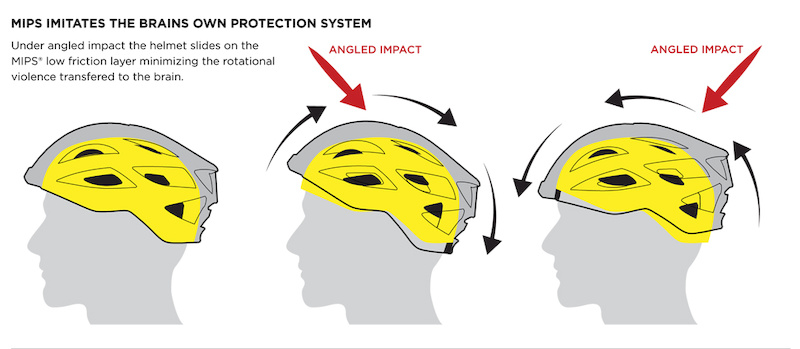When it comes to mountain biking, your helmet isn’t just a piece of gear; it’s your lifeline. As we roll into 2024, the leaps in helmet technology aren’t just impressive—they’re game-changers, offering riders unparalleled protection and comfort. In this guide, we’ll explore the top innovative features making their mark in this year’s mountain bike helmet safety.
MIPS Technology: A New Standard in Protection
What is MIPS in Mountain Bike Helmets?
MIPS (Multi-directional Impact Protection System) represents a revolutionary approach to helmet safety, specifically designed to offer better protection in the event of angled impacts. At its core, MIPS is a low-friction layer within the helmet that allows a controlled amount of rotation upon impact. This movement mimics the brain’s own protective mechanism, reducing the rotational forces transmitted to the brain, which can significantly lower the risk of brain injuries.
How Does MIPS Enhance Rider Safety?
The real-world application of MIPS technology in mountain biking cannot be understated. Angled impacts are common during falls in mountain biking, and traditional helmets without MIPS may not be as effective in mitigating the rotational forces that contribute to severe brain injuries. By allowing relative movement between the head and the helmet, MIPS-equipped helmets can absorb and redirect those harmful forces, offering an additional layer of safety. For further investigation find for example this study about “Influences on the Risk of Injury of Bicyclists’ Heads and Benefits of Bicycle Helmets in Terms of Injury Avoidance and Reduction of Injury Severity.”

Why Has MIPS Become a Standard in 2024?
As we move into 2024, MIPS technology has transitioned from being a premium feature found only in high-end helmets to a standard safety feature expected in most mountain bike helmets. This shift is largely due to the growing body of research supporting its efficacy and an increasing consumer demand for higher safety standards. Manufacturers have responded by integrating MIPS into a wider range of their helmet models, making this advanced protection technology accessible to a broader audience of riders.
Are There Different Types of MIPS?
Yes, MIPS technology has evolved, and there are now different versions tailored to various sports and helmet types, including specific models for mountain biking. These variations are designed to address the unique demands and impact scenarios of each sport, ensuring optimal protection. For mountain bikers, this means helmets equipped with MIPS are not just safer; they’re also designed with the rider’s experience in mind, balancing safety with comfort and performance.
Embedding a product comparison chart or a link to a helmet buying guide that highlights different MIPS-equipped helmets could be valuable here, aiding readers in making informed purchasing decisions.
Enhanced Ventilation Systems: Keeping Cool Under Pressure
How Important is Ventilation in Mountain Bike Helmets?
Ventilation in mountain bike helmets is crucial, not just for rider comfort, but also for overall performance. Effective ventilation systems are designed to promote airflow across the head, which helps in regulating temperature and reducing sweat buildup during rides. This is particularly important in mountain biking, where varying terrains and intensities can cause body temperature to fluctuate rapidly. Helmets with enhanced ventilation systems ensure that riders stay cool and comfortable, even on the most challenging climbs or during intense summer rides.
An image or diagram illustrating airflow through a helmet’s ventilation system could be helpful here to visually demonstrate how ventilation works.
Can Enhanced Ventilation Impact Helmet Safety?
A common question among riders is whether the quest for better ventilation compromises helmet safety. The answer is, not necessarily. Helmet manufacturers have mastered the art of balancing safety with ventilation. Using advanced materials and smart design, 2024 helmets maintain structural integrity and protection, even with extensive venting. Computational Fluid Dynamics (CFD) and other simulation tools help designers to model and optimize helmet structures, ensuring that ventilation enhancements do not detract from safety performance.
This section could be complemented by a case study or a research summary link, showing how helmet safety is tested and maintained in the design process.
Lightweight Materials: Forget You’re Even Wearing It
Why is Helmet Weight Important for Mountain Bikers?
Helmet weight plays a critical role in the overall mountain biking experience. Lighter helmets reduce strain on the neck and shoulders, leading to less fatigue and a more comfortable ride, especially during long or challenging trails. A lightweight helmet can significantly improve maneuverability and rider agility, allowing for better control and focus on the trail. For mountain bikers who spend hours on the trail, the difference a few ounces can make is not just about comfort but can also impact performance and endurance.
An infographic showing the comparison between the weights of standard and lightweight helmets and their impact on rider comfort and performance could be visually engaging here.
What Materials are Making 2024 Helmets Lighter?
The 2024 mountain bike helmets are leveraging advanced materials and manufacturing techniques to achieve lighter weights without compromising safety. Materials such as Carbon Fiber, Expanded Polystyrene (EPS), and Koroyd have been instrumental in this evolution. Carbon fiber is renowned for its high strength-to-weight ratio, offering robust protection with minimal bulk. EPS is a lightweight, impact-absorbing foam that’s become a staple in helmet construction. Koroyd, with its unique honeycomb structure, provides excellent energy absorption while significantly reducing weight. These materials, combined with innovative design approaches, have ushered in a new era of ultralight helmets that offer superior protection.
Linking to detailed descriptions or studies on these materials could provide readers with deeper insights into why and how they contribute to lighter, safer helmets.
How Do Lightweight Helmets Maintain Safety Standards?
Despite their reduced weight, lightweight helmets in 2024 do not compromise on safety. Thanks to the strategic use of high-strength materials and advanced engineering, these helmets meet and often exceed safety standards. Technologies like In-Mold construction, which fuses the helmet’s outer shell with the impact-absorbing foam liner, create a stronger structure without adding weight. Additionally, safety certifications and rigorous testing ensure that these lightweight helmets provide the necessary protection mountain bikers need.
Including a section on safety certifications, possibly with an outgoing link to certification bodies like CPSC, ASTM, or EN, could reassure readers about the reliability of these lightweight helmets.
Are Lightweight Helmets Worth the Investment?
For serious mountain bikers, investing in a lightweight helmet can be a game-changer. The benefits of reduced fatigue, increased comfort, and sustained performance make these helmets worth considering. While they may come with a higher price tag, the long-term advantages they offer in terms of enjoyment and endurance on the trails can justify the investment. As with any high-performance gear, the right helmet can enhance the biking experience, making it easier for riders to tackle more challenging rides and improve their skills.
This could be a good place to link to product reviews or comparative analyses of lightweight helmets, offering readers tangible evidence of the benefits and helping guide their purchase decisions.
Visibility and Connectivity: Be Seen, Be Safe
Why is Visibility Important in Mountain Bike Helmets?
Visibility is a critical safety feature for mountain bikers, especially for those who ride in low-light conditions or share trails with other bikers and hikers. High-visibility helmets can significantly reduce the risk of accidents by ensuring that riders are seen by others. This is particularly important during dawn, dusk, or when navigating through densely wooded areas where visibility is naturally lower. Enhancing helmet visibility through reflective materials, bright colors, and integrated lighting not only makes for safer rides but also instills confidence in riders, knowing they are more visible to others.
Consider adding an image showing a rider with a high-visibility helmet in a low-light setting to visually emphasize the importance.
What Features Enhance Helmet Visibility in 2024?
The 2024 mountain bike helmets have taken visibility to the next level with features like integrated LED lights, reflective strips, and fluorescent colors. LED lights, often positioned at the back of the helmet, provide a bright, noticeable signal to others behind the rider. Reflective materials incorporated into the helmet design catch and reflect light, making the helmet stand out in the beam of vehicle headlights or other light sources. Fluorescent colors are designed to be ultra-visible in daylight, particularly in the ultraviolet spectrum, where they appear to ‘glow,’ drawing attention to the rider.
Linking to a study or article on the effectiveness of these visibility features in preventing accidents could provide valuable context and support for their inclusion in helmets.
How Does Connectivity Enhance Safety in Mountain Biking?
Connectivity, particularly through Bluetooth technology, has become an increasingly common feature in mountain bike helmets, enhancing safety in several ways. It allows riders to stay connected without the need to handle a phone or other devices, reducing distractions and keeping hands on the handlebars. With built-in speakers and microphones, riders can receive navigation cues, take calls, or listen to music safely. Moreover, some connected helmets are equipped with SOS features that can alert emergency contacts in case of an accident, providing an additional layer of safety for riders.
Embedding a video demonstration of these connectivity features in action, such as hands-free calling or SOS alerts, could be highly engaging and informative for readers.
Are Integrated Lights and Connectivity Features Reliable?
Reliability is a key concern when it comes to integrated lights and connectivity features in helmets. The 2024 models have addressed this with robust designs and long-lasting batteries to ensure that these features are dependable, even on long rides. Helmets are designed to withstand the rigors of mountain biking, with weather-resistant features to protect against rain and mud. Battery life has also seen improvements, with many models offering easy USB charging and long-lasting performance to ensure that riders remain visible and connected throughout their ride.
This section could benefit from a link to customer reviews or testimonials that attest to the reliability and durability of these features in real-world conditions.
Get the Best Fit: Helmet Adjustments Simplified
How Do I Ensure My Mountain Bike Helmet Fits Properly?
Ensuring a proper fit for your mountain bike helmet is paramount for both safety and comfort. Start by selecting the right size helmet for your head circumference. Once you have the right size, adjust the dial at the back of the helmet to tighten or loosen the fit until it feels snug but not overly tight. The helmet should sit level on your head, covering the forehead without tilting backward or forward. The straps should form a ‘V’ shape around your ears and fasten securely under your chin without causing discomfort.
An image showing the correct helmet position and strap arrangement could be helpful here for visual guidance.
What Adjustments Can I Make for a Better Helmet Fit?
Modern mountain bike helmets come with a range of adjustments to help you achieve the best fit. Beyond the rear dial adjuster, look for helmets with adjustable strap dividers that allow you to fine-tune the fit around your ears. Additionally, many helmets include interchangeable pads of varying thicknesses. These can be used to adjust the internal fit of the helmet, accommodating different head shapes and ensuring a secure fit without pressure points.
Including a link to a detailed guide or video on customizing helmet fit with pads and strap adjustments could be beneficial for readers seeking more in-depth information.
Can I Adjust My Helmet While Wearing Gloves?
Yes, many of the latest mountain bike helmets are designed with glove-friendly adjusters. These larger, more tactile dials and clasps allow you to make quick fit adjustments even while wearing full-finger gloves, ensuring you can always get a perfect fit without having to stop and remove your gloves. This is especially useful during colder weather rides or when adjustments are needed mid-ride.
Showing a short video clip or an animated GIF of adjustments being made with gloves on could illustrate this feature’s convenience.
Conclusion: The Future of Mountain Bike Helmet Safety is Now
What Are the Latest Innovations in Mountain Bike Helmet Safety?
The future of mountain bike helmet safety is characterized by cutting-edge innovations that are available today. From MIPS technology for enhanced protection against rotational forces to advanced materials that make helmets lighter and stronger, the industry is continuously evolving. Ventilation systems have become more sophisticated, ensuring comfort without compromising safety. Moreover, visibility and connectivity features like integrated LED lights and Bluetooth have become standard, offering riders unprecedented safety and convenience.
An image showcasing a helmet with all these features could visually sum up the advancements in helmet technology.
How Will Helmet Safety Continue to Evolve?
Helmet safety is set to evolve with advancements in materials science, digital technology, and our understanding of brain injuries. Future helmets may incorporate smart technologies like impact sensors and real-time monitoring systems to provide immediate feedback on the severity of a fall. Additionally, we might see the integration of augmented reality for navigation and hazard detection, further enhancing rider safety and experience.
Linking to a research article or white paper on future helmet technologies could offer readers a glimpse into what’s on the horizon.
Why is Staying Updated with Helmet Technology Important?
Staying updated with the latest in helmet technology is crucial for ensuring maximum protection and comfort. As our understanding of head injuries improves and technology advances, new features and materials are developed to enhance helmet safety. By keeping informed about these advancements, riders can make educated decisions about their safety gear, ensuring they benefit from the best protection available.
Including a call-to-action linking to a newsletter sign-up or a blog dedicated to the latest in biking safety gear can encourage readers to stay informed.
How Can I Ensure I’m Using the Most Advanced Helmet?
To ensure you’re using the most advanced helmet, regularly review the latest releases from reputable helmet manufacturers and check independent safety ratings and reviews. Look for helmets that incorporate the latest safety features and materials and are certified by recognized safety standards. It’s also beneficial to attend trade shows or exhibitions where you can see the latest helmet technology firsthand.
Embedding a comparative review video or an interactive comparison chart of the latest helmets could help readers make informed decisions.



